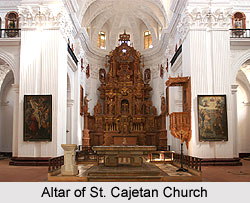 The Church of St. Cajetan is located in Old Goa opposite the church of Se Cathedral. The church is built in Corinthian style of architecture, both externally and internally. However, the gilded altars with rich carvings are in Baroque style. The church was built by Italian friars of the Order of Theatines who were sent by Pope Urban III to preach Christianity in the kingdom of Golkonda. They were not allowed to work there hence they settled down in Goa in 1640. The Church of St. Cajetan bears a striking resemblance to the original design of St. Peter`s Church in Rome.
The Church of St. Cajetan is located in Old Goa opposite the church of Se Cathedral. The church is built in Corinthian style of architecture, both externally and internally. However, the gilded altars with rich carvings are in Baroque style. The church was built by Italian friars of the Order of Theatines who were sent by Pope Urban III to preach Christianity in the kingdom of Golkonda. They were not allowed to work there hence they settled down in Goa in 1640. The Church of St. Cajetan bears a striking resemblance to the original design of St. Peter`s Church in Rome.
The church is built of laterite blocks, which were lime-plastered. The facade has two towers on either side. The pediment is supported by Corinthian columns and pilasters. There are four niches that house the statues of the apostles. The church looks like a Greek cross. It has a nave ending in an apse and aisles marked by four massive piers. These piers also serve as the base for supporting a circular dome that rests on a drum and was crowned by a lantern. The ribbed vaults of the nave and aisles vary in their heights. These have been well decorated with floral designs. There are two octagonal rooms here that are surmounted by domical roofs on either side of the main altar.
Apart from the chief altar the Church of St. Cajetan has six other altars. These are all dedicated to Our Lady of Divine Providence. The altars have been intricately carved with artistic designs and look very appealing. They are gilded in Baroque style with twisted shafts and are adorned with figures of angels. They have also been beautifully painted and depict instances from the life of St. Cajetan. The niches running along the sides of the vault have wooden statues of saints. On the left of the main entrance of the church there are three altars dedicated to the Holy Family, Our Lady of Piety and St. Clare, while to the right are those dedicated to St. John, St. Cajetan and St. Agnes.
The Italian friars of the Order of Theatines attained the site in 1655 by a Royal Order and finally the church was built in the seventeenth century.
Renovation of St. Cajetan
The ASI`s Mini Circle of Goa had carried out renovation work in the Church of St. Cajetan. The wooden pedestal of the altar was re-plastered. The decorated mouldings of the pillars were also repaired. The walls of the church have been freshly painted and the floor was re-laid with red-oxide.











